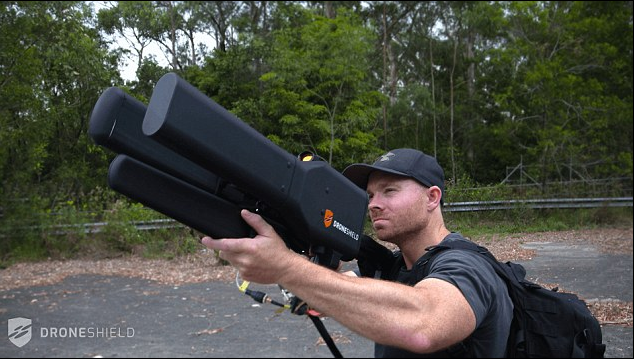The Critical Element in Anti-Drone Technologies
Anti-drone technologies are making headlines as security concerns increase along with the proliferation of civilian drones. Some of the technologies are arguably low-tech (e.g., catch a drone with a net carried by another drone). Others seem straight out of Buck Rogers. Case in point: The DroneGun produced by Sydney-based DroneShield that was dubbed a ‘death ray’ in an article by Harry Pettit published today in the DailyMail.com. The product is a rifle-looking instrument that emits directional radio frequency jamming signals to jam the GPS on the target drone and jam the video signal being transmitted by the drone. DroneShield claims the DroneGun has an effective radius of 2 kilometers (1.2 miles).
Although the gun looks really cool and the range sounds impressive, let’s examine some of the challenges associated with its use. First, the gun is useless if the operator does not know where the intruder drone is. Although drones are noisy, they are only noisy when they are relatively close by. Any typical consumer drone becomes effectively silent to the unaided ear, and invisible to the unaided eye, when it is more than a few hundred yards away (recall there are 1760 yards in a statute mile). Thus, drone detection must be performed first and at a sufficient distance that the drone can be disabled before it has come close enough to cause trouble. The headlines did not discuss the fact that DroneShield also sells detection sensors. However, DroneShield’s “Long-Range Sensor” is claimed to be able to detect drones at ranges of up to 1 km (0.6 mile). Thus, half of the DroneGun’s range is not usable since an intruder drone will not be detected at distances greater than 1 km.
Now let’s assume an intruder drone has been detected at a range of 1 km. The process of finding a half-meter wide drone at a distance of 1 km in a rifle scope is challenging indeed. This could be aided through the use of an attitude-sensing system to aid the operator in pointing at the correct portion of the sky. Alternatively, the gun could be mounted on a pan-tilt mechanism and automatically pointed in accordance with the information provided by the detection sensor. This is a bit complicated but poses no great technological hurdle. An automated system, with a human monitoring it, seems likely to be needed in order to disable drones at maximum distances. This will be critical since civilian drone regulations permit speeds of up to 100 mph. At this speed, a drone can travel 1 km in a little under 22 seconds.
Clearly there will be cases in which the DroneGun technology will be helpful even in the hands of a human operator. Fans that bring their drone to a stadium to get a great selfie may launch their toy during a tailgate party and not realize they are breaking the law. A beat cop carrying an anti-drone gun could easily disable the drone before any panic ensues. However, in order to exploit the long range capability of an anti-drone gun, detection sensors must have commensurate range and automation will be needed for adequate responsiveness.

